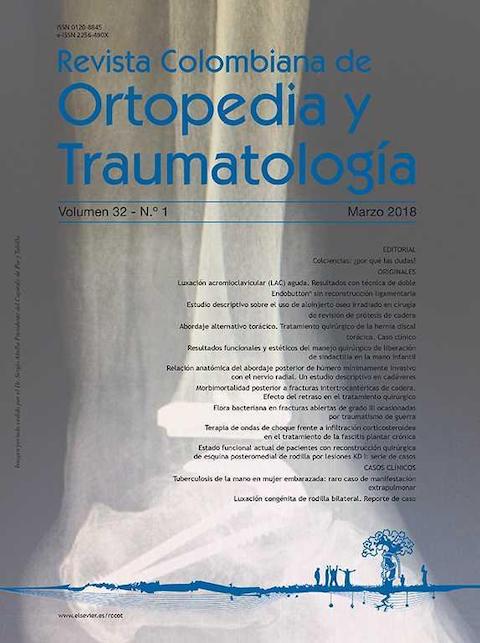Flora bacteriana en fracturas abiertas de grado III ocasionadas por traumatismo de guerra
DOI:
https://doi.org/10.1016/j.rccot.2017.07.006Palabras clave:
fractura abierta, grado III, herida de guerra, profilaxis antibiótica, terapia antibióticaResumen
Introducción: Las heridas de guerra, como las producidas por minas antipersona modificadas, generan lesiones extensas de los tejidos blandos y amputaciones traumáticas, intensamente contaminadas con tierra, vegetación, materia fecal e, incluso, tejidos de otras víctimas. El objetivo del estudio es establecer el tipo de microorganismos que se aíslan en este tipo de lesiones.
Materiales y métodos: Estudio descriptivo retrospectivo, del tipo serie de casos, realizado entre enero de 2012 y diciembre de 2014, en el cual se incluyó a todos los pacientes con heridas por proyectil de arma de fuego, armas de fragmentación o minas antipersona, que presentaban compromiso de tejido óseo, cultivos bacteriológicos óseos y/o tejidos blandos con reporte definitivo y pruebas de sensibilidad a los antibióticos en los gérmenes aislados.
Resultados: Se incluyó a 126 pacientes y se encontró que el 72% de estos presentaba una fractura abierta de gradoIIIA y el 25%, de grado IIIB. Las bacterias gramnegativas fueron las mayormente aisladas en cultivos (41%). Enterococcus faecalis fue la bacteria aislada con mayor frecuencia (15%), seguido por Pseudomonas aeruginosa (13%).
Discusión: Se puso de manifiesto que el 52% de los gérmenes aislados presentaba algún tipo de resistencia al manejo antibiótico empírico que se les aplica como protocolo en el momento del ingreso (cefalosporina + aminoglucósido y ciprofloxacino + clindamicina en caso de armas de fragmentación). Esto establece un nuevo reto médico y quirúrgico para todos los responsables del manejo integral de estos pacientes.
Nivel de evidencia clínica: Nivel III.
Descargas
Referencias bibliográficas
Suárez F, Satizábal C, Calderón O, Ramírez V, García A, Náquira LF. Flora bacteriana en heridas de guerra. Experiencia de dos años en el Hospital Militar Central de Bogotá. Rev Med. 2008;16:127-33.
Fries CA. Prospective randomized controlled trial of nanocrystalline silver dressin versus plain gauze as the initial postdebridement management of military wounds on wound microbiology and healing. Injury. 2014;45:1111-6. https://doi.org/10.1016/j.injury.2013.12.005
Hansraj KK, Weaver LD, Todd AO, Taylor SM, Griffin MD, Dukhram KM, et al. Efficacy of Ceftriax- one versus Cefazolin in the prophylactic management of extra-articular cortical violation of bone due to low-velocity gunshot wounds. Orthop Clin North Am. 1995;26:9-17. https://doi.org/10.1016/S0030-5898(20)31963-5
Ordog GJ, Balasubramaniam S, Wasserberger J. Outpatient management of 357 gunshot wounds to the chest. J Trauma. 1983;28:832-5. https://doi.org/10.1097/00005373-198309000-00008
Knapp TP, Patzakis MJ, Lee J, Seipel PR, Abdollahi K, Reisch RB. Comparison of intravenous and oral antibiotic therapy in the treatment of fractures caused by low-velocity gunshots. J Bone Joint Surg. 1996;78-A:1167-71. https://doi.org/10.2106/00004623-199608000-00006
Bartlett CS, Helfet DL, Hausman MR, Strauss E. Ballistics and gunshot wounds: effects on musculoskeletal tissues. J Am Acad Orthop Surg. 2000;8:21-36. https://doi.org/10.5435/00124635-200001000-00003
Court-Brown CM, McQueen MM, Quaba AA, editores. Management of open fractures. London: Martin Dunitz; 1996.
Court-Brown CM, Rimmer S, Prakash U, McQueen MM. The epidemiology open long bone fractures. Injury. 1998;29:529-34. https://doi.org/10.1016/S0020-1383(98)00125-9
London, P.S.,London PS. Medical lessons from the Falkland Islands' campaign. Report of a meeting of the United Services Section of the Royal Society of Medicine held at the Royal College of Surgeons on February 17 and 18, 1983. J Bone Joint Surg Br. 1983;65:507-10. https://doi.org/10.1302/0301-620X.65B4.6874724
Jackson DS, Batty CG, Ryan JM, McGregor WS. The Falklands War: Army field surgical experience. Ann R Coll Surg Engl. 1983;65:281-5.
Ryan JM, Cooper GJ, Haywood IR, Milner SM. Field surgery on a future conventional battlefield: strategy and wound management. Ann R Coll Surg Engl. 1991;73:13-20.
Batinica J, Batinica S. War wounds in the Sibenik area during the 1991-1992 war against Croatia. Mil Med. 1995;160:124-8. https://doi.org/10.1093/milmed/160.3.124
Burkle FMJM, Newland C, Meister SJ, Blood CG. Emergency medicine in the Persian Gulf War-Part 3: Battlefield casualties. Ann Emerg Med. 1994;23:755-60. https://doi.org/10.1016/S0196-0644(94)70311-6
Mehran R, Connelly P, Boucher P, Cote M. Modern war surgery: the experience of Bosnia. 2: the clinical experience. Can J Surg. 1995;38:338-46.
Uhorchak JM, Arciero RA. Recent wounds of war: lessons learned and relearned. Tech Orthop. 1995;10:176-88. https://doi.org/10.1097/00013611-199501030-00007
Covey DC. Blast and fragment injuries of the musculoskeletal system. J Bone Joint Surg Am. 2002;84:1221-34. https://doi.org/10.2106/00004623-200207000-00022
Anderson JT, Gustilo RB. Immediate internal fixation in open fractures. Orthop Clin North Am. 1980;11:569-78. https://doi.org/10.1016/S0030-5898(20)31458-9
Barach E. Ballistics: a pathophysiologic examination of the wounding mechanisms of firearms. Part II. J Trauma. 1986;26:374-83. https://doi.org/10.1097/00005373-198604000-00012
Brettler D. Conservative treatment of low velocity gunshot wounds. Clin Orthop. 1979;140:26-31. https://doi.org/10.1097/00003086-197905000-00006
Davis GL. Management of open wounds of joints during the Vietnam war. Clin Orthop. 1970;68:3-9. https://doi.org/10.1097/00003086-197001000-00002
DeMuth WE, Smith JM. High velocity bullet wounds of muscle and bone: the basis of rational early treatment. J Trauma. 1966;6:744-55. https://doi.org/10.1097/00005373-196611000-00006
Descargas
Publicado
Cómo citar
Número
Sección
Licencia
Derechos de autor 2024 Revista Colombiana de ortopedia y traumatología

Esta obra está bajo una licencia Creative Commons Reconocimiento 3.0 Unported.








